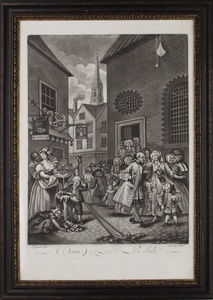| Method | Mezzotint |
| Artist | Charles Spooner after William Hogarth |
| Published | [Publish'd 23rd June 1740] |
| Dimensions | Image 333 x 251 mm, Plate 359 x 253 mm |
| Notes |
A fine, contemporary, mezzotint copy of William Hogarth's 'Noon' engraving from a series of four prints exploring London at different times of the day and year. Titled below image in English and French. The print depicts a scene set at midday, a group of well-groomed French refugees file out of the Huguenot Chapel off the Charing Cross Road. The well turned out man, woman, and child are contrasted with the English group across the street. Here, before the Baptist's Head pub, a black man fondles the breasts of a washerwoman. The boy before her has cracked the plate holding his dinner, spilling it onto the cobblestones, where an urchin girl picks through it. The street is physically divided in two by a gutter, bridged only by the carcass of a dead cat, and invites a clear contrast between the orderly, well-dressed French Huguenots and the unruly natives of the parish of St Giles in the Fields, the spire of which appears in the background. The paintings upon which the original engravings are based were originally executed by Hogarth for the Vauxhall supper-boxes. Although issued as a series, unlike Hogarth's Progress types, the Four Times of the Day was intended to highlight contrasts and contradictions rather than a moral narrative, focussing instead on the comparison of class and character in various parts of London. As Paulson comments, in form the series take some inspiration from earlier allegorical series, the pastoral scenes replaced or subverted by scenes of the town, and with Hogarth's characters acting as parodies of traditional allegorical figures. Charles Spooner (died 1767) was an Irish mezzotint engraver, who worked in London towards the end of his life. Before 1756, Spooner travelled to London, where he primarily worked on producing copies of plates by other engravers for Robert Sayer and Carington Bowles. William Hogarth (1697 - 1764) was born in London, the son of an unsuccessful schoolmaster and writer from Westmoreland. After apprenticeship to a goldsmith, he began to produce his own engraved designs in about 1710. He later took up oil painting, starting with small portrait groups called conversation pieces. He went on to create a series of paintings satirising contemporary customs, but based on earlier Italian prints, of which the first was The Harlot's Progress (1731), and perhaps the most famous The Rake's Progress. His engravings were so plagiarised that he lobbied for the Copyright Act of 1735, commonly referred to as 'Hogarth's Act,' as a protection for writers and artists. During the 1730s Hogarth also developed into an original painter of life-sized portraits, and created the first of several history paintings in the grand manner. Paulson records Spooner's set of four prints as "Publish'd 23rd June 1740". Paulson p104, BM Satires 2366 (Morning), Lennox-Boyd i/i. Condition: Excellent clean impression. Framed in period style frame. Previously with Isaac and Ede. |
| Framing | framed |
| Price | £600.00 |
| Stock ID | 52318 |

